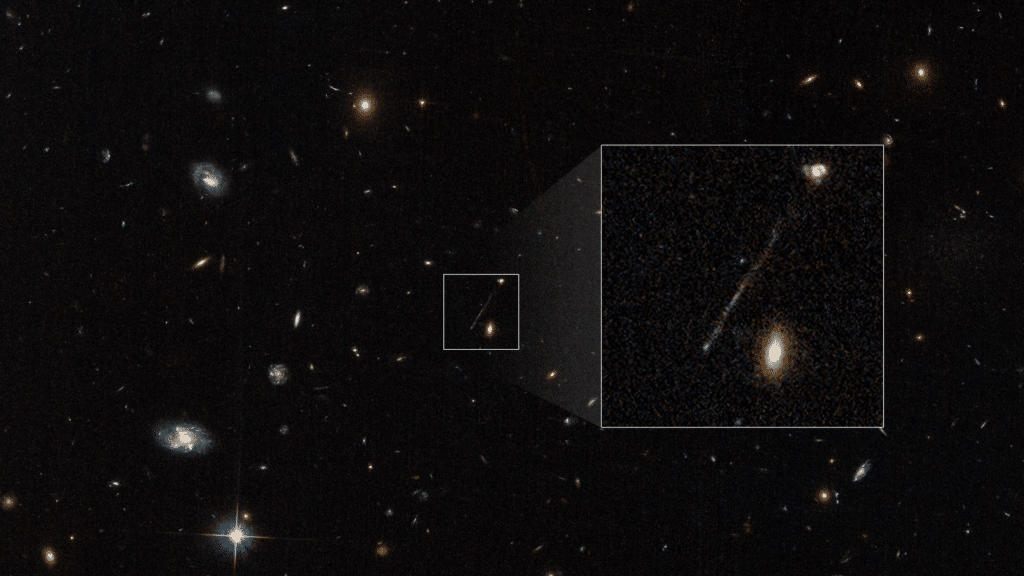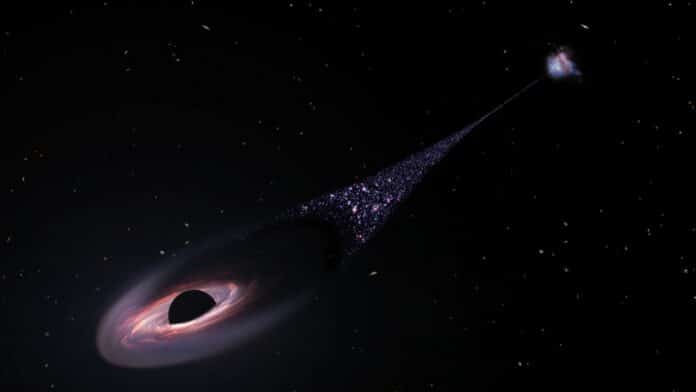There is an unseeable object- black-hole- wandering through intergalactic space so fast, if it were in the solar system, it could travel from Earth to Moon within 14 minutes. NASA’s Hubble Space Telescope accidentally recorded it, and it has never been seen before.
The black hole- weighing as much as 20 million Suns– is streaking too fast to take time for a snack. It has left behind a never-before-seen 200,000-light-year-long “constrail” of newborn stars. It’s likely the result of a rare, bizarre game of galactic billiards among three massive black holes.
The column, which extends back to its home galaxy, has a black hole at one end. The outermost point of the column is where a strikingly bright knot of ionised oxygen can be found. The speed of the black hole striking the gas is likely shocking and heating it, according to researchers. Alternatively, radiation from an accretion ring around the black hole could be the cause.
Pieter van Dokkum of Yale University in New Haven, Connecticut, said, “We’re seeing a wake behind the black hole where the gas cools and can form stars. What we’re seeing is the aftermath. Like the wake behind a ship, we see the wake behind the black hole.”

“Gas in front of it gets shocked because of this supersonic, high-velocity impact of the black hole moving through the gas. How it works exactly is not known.”
“This is pure serendipity that we stumbled across it. I was just scanning the Hubble image and noticed that we have a little streak. I immediately thought, ‘Oh, a cosmic ray hitting the camera detector and causing a linear imaging artifact.’ When we eliminated cosmic rays, we realized it was still there. It didn’t look like anything we’ve seen before.”
Due to its weirdness, scientists did follow-up spectroscopy with the W. M. Keck Observatories in Hawaii.
According to van Dokkum, The star trail is astonishing, bright, and unusual. This led to the conclusion that he was looking at the aftermath of a black hole flying through a halo of gas surrounding the host galaxy.
Supermassive black holes are likely to have collided several times to cause this intergalactic explosion. According to astronomers, the first two galaxies may have fused 50 million years ago. Two supermassive black holes at their centers came together as a result. They rotated like a binary black hole around one another.
The binary black holes launched in the opposite direction from the single black hole’s initial trajectory. The runaway binary black hole may be the object visible on the other side of the host galaxy. The lack of any indication that an active black hole is still present at the galaxy’s center serves as circumstantial evidence for this.
Journal Reference:
- Pieter Van Dokkum, Imad Pasha et al. A Candidate Runaway Supermassive Black Hole Identified by Shocks and Star Formation in its Wake. The Astrophysical Journal Letters. DOI 10.3847/2041-8213/acba86
